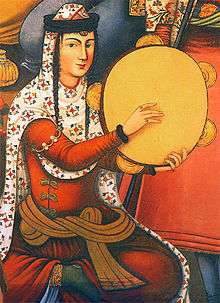Sanj
Sanj or Senj (Persian سنج) is a metallic percussion instrument, like a cymbal, but much larger in diameter, in the form of cup- or bell-shaped plates. Other names for Sanj, are Zang, Chalab, and Boshqābak.
Etymology
All theories about the etymology of the word Sanj, identify it as a Pahlavi word. By some accounts means weight; and it is possible that the original term was Sanjkūb meaning ”striking weights” [against each other].[1] By some accounts the word is reform version of "Zang" (bell), referring to its belle-shaped plate.
History and Function
The instrument consists of cup- or bell-shaped round plates of various alloys, mainly brass or tin. The earliest record of its usage in Persian literature is of Ferdowsi’s masterpiece, Shahname. It referred to Sanj as a military-musical-instrument that was used by the legendary Iranian king, Q-mars. It was a favourite of King Key-Kavus and the Hero Rostam.
About King Key Kavus:
- Kavus received them graciously and taught them
- New laws and ways. Anon the sound of bells
- And cymbals rose with shouts and clarion-blare,
- And he departed westward toward Mount Kaf.
About Mazandaran, and what Rustam did:
- His elephant-attendants' crowns of gold,
- Their golden girdles and their golden torques,
- Their golden Sanj (cymbals) and their golden Zang (bells),
- Unmatched on earth, his jeweled parasol
- Of peacocks' tails, these will we seize, and more,
- When we are fighting with our lives at stake."
Hamzehnameh, which draws upon myth, literature and history, refers to Sanj as the instrument of Q-mars: "One morning, to sound the call for battle, Hamza ordered Alexander’s drum, Jamshed’s Sorna, and Gayomarth’s Sanj sounded. According to the Persian mythology, Q-mars (Gayomarth) is the first man created by Ahura Mazda, and the first King of the world."[2]
In other Persian literary works of Safavid era, Sanj was used as a lamentation instrument, especially during the Ashura. Sanj was used in the "Stone beating" symbolic rite, which still is popular in several parts of Iran.
Ashura ceremony
During the Ashura ceremony, normally two pieces of stone are beaten on the sides of the mourner with special movements accompanied by a lamentation song. Apparently as a result of the physical damage caused by stones on the body, wood sticks gradually replaced stone. Lately instead of stone beating other terms such as Karbzani or Karebzani, playing Sanj and ratchets are used. In Mazandaran and regions such as Qomesh, south of Alborz Mountain, the term Kareb and in Gilan the term Karb is customary. In Aran district of Kashan, sanj is used. This ceremony requires performers with considerable physical strength and is popular in Lahijan and Aran of Kashan, as well as Semnan and Sabzevar.


